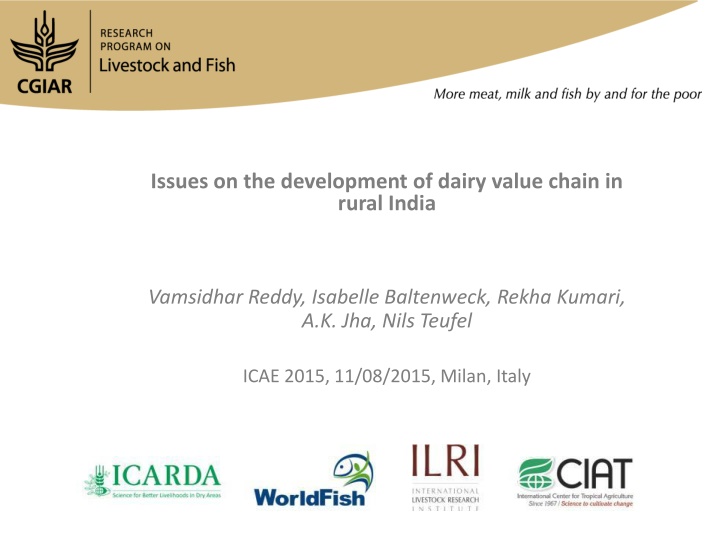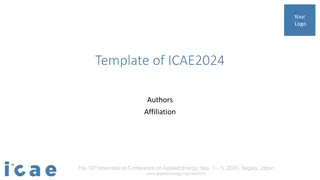
Challenges and Opportunities in Dairy Value Chain Development in Rural India
Explore the complexities of dairy value chain development in rural India, focusing on key issues, constraints, and potential solutions. This study delves into the characterization of dairy production systems, identifying barriers to participation, and strategies for upgrading and expanding the value chain. Insights from selected sites in Bihar shed light on the unique challenges faced by smallholder dairy producers and the paths to sustainable improvement.
Download Presentation

Please find below an Image/Link to download the presentation.
The content on the website is provided AS IS for your information and personal use only. It may not be sold, licensed, or shared on other websites without obtaining consent from the author. If you encounter any issues during the download, it is possible that the publisher has removed the file from their server.
You are allowed to download the files provided on this website for personal or commercial use, subject to the condition that they are used lawfully. All files are the property of their respective owners.
The content on the website is provided AS IS for your information and personal use only. It may not be sold, licensed, or shared on other websites without obtaining consent from the author.
E N D
Presentation Transcript
Issues on the development of dairy value chain in rural India Vamsidhar Reddy, Isabelle Baltenweck, Rekha Kumari, A.K. Jha, Nils Teufel ICAE 2015, 11/08/2015, Milan, Italy
Background Livestock and Fish CRP s Dairy Value Chain Transformation in Bihar Value Chain Assessments as first characterisation step towards collecting insights and evidence for successful value chain interventions. 4 selected locations in Nalanda district Assessment objectives: Characterize the dairy production systems and value chain in a particular site Determine constraints, barriers to participation by poor men and women Identify opportunities for value chain upgrading and expansion, considering associated risks with particular regard to feeds, breeding, animal health and food safety Develop solutions and opportunities for improvement 2
Selection of sites Locations selected to represent different conditions Mahammadpur village [with VC interventions] Ekangarsarai block Rural to Urban value chain Kesopur village [without interventions] Kharuwara village [with interventions] Harnaut block Urban to Urban value chain Mushari village [without interventions] 4
The Approach Applied to all 6 value chain projects Information collected from Producers, by group discussions (FGD) and other value chain actors, randomly selected, by individual interviews (KII). Value Chain Actors Farmer Livestock feed provider Health and breeding service provider Milk traders/village level collectors Processors/Retailer Milk Societies Consumer Participants 299 5 5 6 9 2 12 FGD 4 -- -- -- -- -- -- KII -- 5 5 6 9 2 12 5
The Tool for Value Chain Assessments Producers: standardized combination of group discussion exercises Tool Introduction A-Livelihoods analysis B-Seasonal calendar C-Gender roles (activity clock) D-Decision making E-Group membership / collective action F-Objectives and systems for dairy production G-Value chain mapping H-Feeds and feeding I-Breeding / Seed input J-Constraints and solutions Closing Duration (hr) 0.5 0.5 1 1 0.5 0.5 1 2 1 1 1 0.25 Type of group Plenary Genders separated Genders separated Genders separated Genders separated Mixed gender Genders separated Genders separated Mixed gender Mixed gender Plenary Plenary Other VC actors : standardized key informant interviews 6
Seasonal Calendars Seasonal calendars provide information about rainfall, and income & expenditure patterns KHARUARA Mushari Mahammadpur Kesopur VILLAGE NAMES INCOME INCOME INCOME INCOME Name of month Rainfall Jan Feb March Apr May June July Aug Sept Oct Nov Dec AI LW LI Rainfall AI LW LI Rainfall AI LW LI Rainfall AI LW LI Income Expenditure Name of monthAgriculture Livestock Income Labor Wages Agriculture Expenditure Livestock Expenditure Personal Expenditure Income Jan Feb March Apr May June July Aug Sept Oct Nov Dec 7
Gender Activity Clocks Gender activity clocks illustrate gender roles in different villages 8
Mapping of value chains Several details about the types of value chains and their components in peri-urban and rural scenarios. 9
Several Value Chains Consumers (rural & peri-urban) Sweet maker COMFED / Milk societies Cottage processor Traders Producers 10
Results 1: Issues in the value chain Unsatisfactory milk price levels In-transparent price formation Limited trust in quality control (milk fat testing) Limited storage & transport facilities (informal trade) Contracts, payments not always clearly documented (even society agreements) Availability of credit variable Limited competition where societies have grown strong 12
Results 2: Issues in Production Animal health: Access to & quality of services, increase in mastitis, parasites Genetic improvement: Quality of AI services Feed & feeding: Knowledge limitations for assessing concentrate feeds From grazing & green fodder -> crop residues Knowledge: Access to extension services Credit: Not available for purchasing dairy animals Gender: Women dominate production, absent in marketing and as other VC actors 13
Results 3: Ranked Constraints Constraints Votes from Men Votes from Women Total Votes Lack of trained doctors 115 193 308 Lack of market knowledge for inputs & outputs 91 169 260 Limited availability of concentrate feeds 88 164 252 Lack of credit facility 89 143 232 Doctors fees are high 72 117 189 Cost of feeds is very high 52 89 141 Lack of veterinary facilities 49 82 131 Success rate of insemination is low 49 78 127 Cost of medicines is high 47 79 126 Small number of milk societies 47 78 125 Time requirement for homemade feeds 21 47 68 Black marketing of feeds 17 24 41 Lack of space for keeping ruminants 14 19 33 14
Conclusions 1 What the tool has done well: Characterisation of VC actors Covers lots of topics in great detail Allows many voices to be heard Offers gender differentiated views 15
Conclusions 2 What the tool has not done so well: Determining variation within villages (distribution of land, bovines, breeds, income sources ..) Prioritising constraints beyond default reactions ( we need better vets & prices ) Providing insights into household nutrition Balancing results between producers, other actors & consumers Offer a pathway for analysis 16
Conclusions 3 What have the results provided for further steps? (e.g. quantitative benchmarking survey, best bet identification) Basis for sampling of various actors Shortlist of issues to be considered (validated) Emphasis on gender differences 17
CGIAR Research Program on Livestock and Fish livestockfish.cgiar.org livestockfish.cgiar.org CGIAR is a global partnership that unites organizations engaged in research for a food secure future. The CGIAR Research Program on Livestock and Fish aims to increase the productivity of small-scale livestock and fish systems in sustainable ways, making meat, milk and fish more available and affordable across the developing world.
Presentation layout Main point 6 point smaller than slide title Bullet points 4 point less than main point Font type is Calibri It is advised in one slide maximum 6 bullets We recommend you use images on slides You have to duplicate this slide for more inside pages 21






















